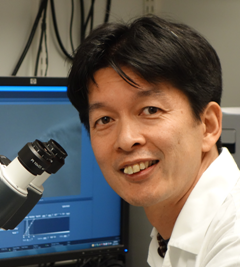Ovarian cancer represents a set of diseases, or subtypes. Each grows differently and responds differently to treatment.
This relatively new finding has led a number of scientists to focus their studies on specific subtypes.
Recent research shows that high-grade serous ovarian cancer, the most common form of ovarian cancer, starts in the fallopian tubes. Little is known about how high-grade serous ovarian cancer develops. But that’s set to change, if Dr. Yojiro Yamanaka has anything to say about it.
“Now that we know high-grade serous ovarian cancer starts in the fallopian tubes, it’s clear that we need a model that shows how the disease develops,” he says. “It would help scientists learn more about this subtype and potentially lead to treatments that target this specific form of the disease.”
Dr. Yamanaka is this year’s recipient of the Pat McDonald Research Award, part of an operating grant co-funded by Ovarian Cancer Canada and the Cancer Research Society. With this support, Dr. Yamanaka and his team at McGill University’s Rosalind and Morris Goodman Cancer Research Centre will explore how high-grade serous ovarian cancer first starts and eventually spreads into the ovaries.

Dr. Yamanaka
“Right now, no one knows how this kind of ovarian cancer originates. But this funding will help us answer questions such as: how the cancer cells initially form in the fallopian tubes, and whether we can catch early stage high-grade serous ovarian cancer before it spreads,” he says. “There could even be opportunities for prevention.”
This is the second grant Dr. Yamanaka has received for research in this area. While relatively new to the study of ovarian cancer, his approach is informed and guided by knowledge he’s earned from studying fertilization and early embryo development.
“As I learned about the origins of high-grade serous ovarian cancer and how little is known about this disease, I became very interested in whether my knowledge of the fallopian tubes could be adapted to advance scientific progress in this area,” says Dr. Yamanaka. “My understanding of how the fallopian tubes function and their processes may help move research further faster.”
“In making their decision with respect to this grant, the selection committee recognized that the uniqueness of this challenge needs to be matched with a unique approach,” he continues. “I appreciate the support and am excited for what’s ahead.”
Your donations help propel important research projects like this one. Plus, Ovarian Cancer Canada’s strategic partnership with the Cancer Research Society stretches your contributions further as they are matched dollar for dollar.


